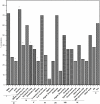Prevalence of antibiotic resistance in commensal Escherichia coli among the children in rural hill communities of Northeast India
- PMID: 29912980
- PMCID: PMC6005495
- DOI: 10.1371/journal.pone.0199179
Prevalence of antibiotic resistance in commensal Escherichia coli among the children in rural hill communities of Northeast India
Abstract
Commensal bacteria are the representative of the reservoir of antibiotic resistance genes present in a community. The usage of antibiotics along with the demographic factors is generally associated with an increase in antibiotics resistance in pathogens. Northeast (NE) India is untapped with regard to antibiotic resistance prevalence and spread. In the current study, the prevalence of antibiotic-resistant commensal Escherichia coli in pre-school and school-going children (n = 550, 1-14 years old) from the rural areas of the state of Sikkim-an NE Indian state, with respect to associated demographic factors was investigated. A total of 550 fecal E. coli isolates were collected during July 2015 to June 2017. A structured questionnaire was used to collect data to ascertain the potential factors associated with the carriage of antibiotic resistance E. coli among the children. Statistical analysis along with a logistic regression identified potential external factors affecting the observed antibiotic resistance pattern. The data indicated a high prevalence of resistance to common antibiotics like ampicillin (92%), ceftazidime (90%), cefoxitin (88%), streptomycin (40%) and tetracycline (36%), but no resistance to chloramphenicol. The resistance to the combination of penicillin and quinolone group of antibiotics was observed in fifty-two percent of the isolates. A positive correlation between the harboring of antibiotics resistant E. coli with different demographic factors was observed such as, with children living in nuclear family (vs joint family 63.15%, OR 0.18, 95% CI:0.11-0.28, p < 0.01), below higher secondary maternal education (vs college graduates 59.27% OR 0.75, 95% CI:0.55-1.02, p < 0.02). A close association between different demographic factors and the high prevalence of antibiotic-resistant commensal E. coli in the current study suggests a concern over rising misuse of antibiotics that warrants a future threat of emergence of multidrug-resistant pathogen isolates.
Conflict of interest statement
The authors have declared that no competing interests exist.
Figures






Similar articles
-
High prevalence of antibiotic resistance in commensal Escherichia coli among children in rural Vietnam.BMC Infect Dis. 2012 Apr 18;12:92. doi: 10.1186/1471-2334-12-92. BMC Infect Dis. 2012. PMID: 22512857 Free PMC article.
-
High levels of drug resistance in commensal E. coli in a cohort of children from rural central India.Sci Rep. 2019 Apr 30;9(1):6682. doi: 10.1038/s41598-019-43227-1. Sci Rep. 2019. PMID: 31040380 Free PMC article.
-
High prevalence of antibiotic resistance in commensal Escherichia coli from healthy human sources in community settings.Sci Rep. 2021 Feb 9;11(1):3372. doi: 10.1038/s41598-021-82693-4. Sci Rep. 2021. PMID: 33564047 Free PMC article.
-
Prevalence and spread of multidrug resistant Escherichia coli isolates among nursing home residents in the southern part of The Netherlands.J Am Med Dir Assoc. 2013 Mar;14(3):199-203. doi: 10.1016/j.jamda.2012.09.026. Epub 2012 Nov 7. J Am Med Dir Assoc. 2013. PMID: 23141211
-
Bacterial characteristics of importance for recurrent urinary tract infections caused by Escherichia coli.Dan Med Bull. 2011 Apr;58(4):B4187. Dan Med Bull. 2011. PMID: 21466767 Review.
Cited by
-
Evidence of Community-Wide Spread of Multi-Drug Resistant Escherichia coli in Young Children in Lusaka and Ndola Districts, Zambia.Microorganisms. 2022 Aug 21;10(8):1684. doi: 10.3390/microorganisms10081684. Microorganisms. 2022. PMID: 36014101 Free PMC article.
-
Prevalence, antimicrobial resistance and biofilm forming ability of Escherichia coli in milk, animal handlers and slurry samples from dairy herds of Punjab, India.Front Vet Sci. 2025 Jun 17;12:1553468. doi: 10.3389/fvets.2025.1553468. eCollection 2025. Front Vet Sci. 2025. PMID: 40599327 Free PMC article.
-
Correlation Between Individual Child-Level Antibiotic Consumption and Antibiotic-Resistant Among Commensal Escherichia coli: Results from a Cohort of Children Aged 1-3 Years in Rural Ujjain India.Infect Drug Resist. 2022 Oct 28;15:6255-6266. doi: 10.2147/IDR.S372093. eCollection 2022. Infect Drug Resist. 2022. PMID: 36329988 Free PMC article.
-
Physicochemical Parameters and Alarming Coliform Count of the Potable Water of Eastern Himalayan State Sikkim: An Indication of Severe Fecal Contamination and Immediate Health Risk.Front Public Health. 2019 Jul 10;7:174. doi: 10.3389/fpubh.2019.00174. eCollection 2019. Front Public Health. 2019. PMID: 31355173 Free PMC article.
-
Antimicrobial Resistance Surveillance in Human Pathogens in Ahmedabad: A One-Year Prospective Study.Indian J Microbiol. 2024 Dec;64(4):1769-1786. doi: 10.1007/s12088-024-01233-6. Epub 2024 Mar 17. Indian J Microbiol. 2024. PMID: 39678984
References
-
- Calva JJ, Cerón C, Calva JJ, Cero C, Diseases I, Nacional I, et al. Antimicrobial resistance in fecal flora: longitudinal community-based surveillance of children from urban Mexico. These include: Antimicrobial Resistance in Fecal Flora: Longitudinal Community-Based Surveillance of Children from Urban Mexico. Antimicrobial Agent and Chemotherapy. 1996;40: 1699–1702. - PMC - PubMed
-
- Laxminarayan R, Chaudhury RR. Antibiotic Resistance in India: Drivers and Opportunities for Action. PLoS Medicine. 2016;13: 1–7. doi: 10.1371/journal.pmed.1001974 - DOI - PMC - PubMed
-
- Bartoloni A, Cutts F, Leoni S, Austin CC, Mantella A, Guglielmetti P, et al. Patterns of antimicrobial use and antimicrobial resistance among healthy children in Bolivia. Trop Med Int Health. 1998;3: 116–123. Available: http://onlinelibrary.wiley.com/store/10.1046/j.1365-3156.1998.00201.x/as... - DOI - PubMed
-
- Wright GD. The antibiotic resistome: the nexus of chemical and genetic diversity. Nature Reviews Microbiology. 2007;5: 175–186. doi: 10.1038/nrmicro1614 - DOI - PubMed
MeSH terms
Substances
LinkOut - more resources
Full Text Sources
Other Literature Sources
Medical

